Fracture Mechanical Properties of Double-Edge Cracked Flattened Brazilian Disc Samples Under Compressive Loads
Abstract
1. Introduction
2. SIFs and T-Stress for DCFBD Samples with Finite Element Method
3. Finite Element Results for DCFBD Samples
3.1. Dimensionless Mode I SIF
3.2. Dimensionless Mode II SIF
3.3. Dimensionless T-Stress
4. Fracture Experiments
5. Conclusions
- A significant number of numerical values for SIFs and T-stress were computed using FEM for DCFBD samples with α = 0.40~0.90, θ = 10°~45°, and γ = 5°~20°. These values play a crucial role in providing accurate descriptions of the compression-shear fracture tests conducted on this sample.
- The effect of γ on YI, YII, and T* is remarkable for DCFBD samples with a smaller α. Nevertheless, it has been observed that for α ≥ 0.60 and γ ≤ 20°, the impact of γ on YI and YII can be disregarded; however, its effect on T* needs to be considered for DCFBD samples with a larger θ.
- As α increases for α ≥ 0.60, the absolute value of YII increases while it decreases with increasing θ. Conversely, there is an opposite trend observed for YI. Moreover, as α increases for α ≥ 0.60, the dimensionless T-stress T* tends to decrease while it increases with an increasing θ.
- The experimental results show that the DCFBD samples with θ = γ = 10° and θ = γ = 15° can effectively achieve true mode II fracture for the two cases of relative crack lengths of 0.70 and 0.80. Furthermore, the average true mode II fracture toughness KIIC of this sandstone is approximately 2.79 MPa m0.5, which significantly exceeds the mode I fracture toughness KIC of 0.97 MPa m0.5, by a ratio of approximately 2.88.
Author Contributions
Funding
Institutional Review Board Statement
Informed Consent Statement
Data Availability Statement
Acknowledgments
Conflicts of Interest
Abbreviations
| DCBD | double-edge cracked Brazilian disc |
| DCFBD | double-edge cracked flattened Brazilian disc |
| DST | direct shear test |
| FEM | finite element method |
| PTS | punch-through shear |
| SBT | shear-box test |
| SCB | semi-circular bending |
| SIFs | stress intensity factors |
| ISRM | International Society for Rock Mechanics |
References
- Huang, S.; Zhang, X.; Yu, W.; Li, X.; Jin, S.; Du, H. A theoretical and experimental Investigation on the fracture mechanism of center-symmetric closed crack in compacted clay under compression–shear loading. Symmetry 2023, 15, 1519. [Google Scholar] [CrossRef]
- Zhou, T.; Chen, J.; Xie, H.; Zhou, C.; Wang, F.; Zhu, J. Failure and mechanical behaviors of sandstone containing a pre-existing flaw under compressive–shear loads: Insight from a digital image correlation (DIC) analysis. Rock Mech. Rock Eng. 2022, 55, 4237–4256. [Google Scholar] [CrossRef]
- Du, H.; Dai, F.; Wei, M.; Li, A.; Yan, Z. Dynamic compression–shear response and failure criterion of rocks with hydrostatic confining pressure: An experimental investigation. Rock Mech. Rock Eng. 2020, 54, 955–971. [Google Scholar] [CrossRef]
- Yan, Z.; Dai, F.; Wang, L.; Jin, J.; Wang, J. Dynamic mode II fracture mechanism of rocks using a novel double-edge notched flattened Brazilian disc specimen in the split Hopkinson pressure bar tests. Eng. Fract. Mech. 2023, 290, 109530. [Google Scholar] [CrossRef]
- Zhang, C.; Li, D.; Su, X.; Luo, P.; Ma, J.; Zhu, Q. Fracture behavior of thermally treated granite under compression-shear loading. Int. J. Rock Mech. Min. Sci. 2024, 184, 105966. [Google Scholar] [CrossRef]
- Zhu, F.; Shi, S.; Liu, F.; Zhu, J. A novel fracture criterion for elastic-brittle cracked body under compression and shear conditions. Fatigue Fract. Eng. Mater. Struct. 2024, 47, 1896–1913. [Google Scholar] [CrossRef]
- Cai, M.; Liu, D. Study of failure mechanisms of rock under compressive–shear loading using real-time laser holography. Int. J. Rock Mech. Min. Sci. 2009, 46, 59–68. [Google Scholar] [CrossRef]
- Gong, H.; Wang, G.; Luo, Y.; Li, X.; Liu, T.; Song, L.; Wang, X. Shear fracture behaviors and acoustic emission characteristics of granite with discontinuous joints under combinations of normal static loads and dynamic disturbances. Theor. Appl. Fract. Mech. 2023, 125, 103923. [Google Scholar] [CrossRef]
- Sun, L.; Li, P.; Luo, B.; Liu, X.; Huang, T.; Su, Y. Dip effect on the orientation of rock failure plane under combined compression-shear loading. Sci. Rep. 2024, 14, 4406. [Google Scholar] [CrossRef] [PubMed]
- Du, K.; Li, X.; Wang, S.; Tao, M.; Li, G.; Wang, S. Compression-shear failure properties and acoustic emission (AE) characteristics of rocks in variable angle shear and direct shear tests. Measurement 2021, 183, 109814. [Google Scholar] [CrossRef]
- Li, S.; Cao, P.; Xiong, X. Strength characteristics and failure behavior of ubiquitous-joint rock-like specimens under compressive-shear stress: Experimental study and digital speckle correlation method. J. Vibroeng. 2019, 21, 1092–1106. [Google Scholar] [CrossRef]
- Zhang, J.; Chen, H.; Wang, H.; Wu, R. Study on Buckling Failure Criterion for Compression-Shear Sliding Unstable Rock. In Proceedings of the 4th Annual International Conference on Material Engineering and Application (ICMEA), Wuhan, China, 15–17 December 2017; pp. 297–302. [Google Scholar]
- Hua, W.; Li, J.; Zhu, Z.; Li, A.; Huang, J.; Dong, S. Experimental study on mode I and mode II fracture properties of heated sandstone after two different cooling treatments. Geomech. Energy Environ. 2023, 34, 100448. [Google Scholar] [CrossRef]
- Wang, L.; Zhou, X. Phase field model for simulating the fracture behaviors of some disc-type specimens. Eng. Fract. Mech. 2020, 226, 106870. [Google Scholar] [CrossRef]
- Yin, T.; Wu, Y.; Wang, C.; Zhuang, D.; Wu, B. Mixed-mode I + II tensile fracture analysis of thermally treated granite using straight-through notch Brazilian disc specimens. Eng. Fract. Mech. 2020, 234, 107111. [Google Scholar] [CrossRef]
- Su, H.; Qin, X.; Feng, Y.; Yu, L.; Sun, Z. Experimental investigation of mixed mode I-II fracture property of thermally treated granite under dynamic loading. Theor. Appl. Fract. Mech. 2022, 118, 103267. [Google Scholar] [CrossRef]
- Zhu, Z.; Wang, L.; Mohanty, B.; Huang, C. Stress intensity factor for a cracked specimen under compression. Eng. Fract. Mech. 2006, 73, 482–489. [Google Scholar] [CrossRef]
- Zhu, Z.M. New biaxial failure criterion for brittle materials in compression. J. Eng. Mech. 1999, 125, 1251–1258. [Google Scholar] [CrossRef]
- Tang, S.B. The effect of T-stress on the fracture of brittle rock under compression. Int. J. Rock Mech. Min. Sci. 2015, 79, 86–98. [Google Scholar] [CrossRef]
- Ayatollahi, M.R.; Aliha, M.R.M. On the use of an anti-symmetric four-point bend specimen for mode II fracture experiments. Fatigue Fract. Eng. Mater. Struct. 2011, 34, 898–907. [Google Scholar] [CrossRef]
- Hua, W.; Li, J.; Gan, Z.; Huang, J.; Dong, S. Degradation response of mode I and mode III fracture resistance of sandstone under wetting–drying cycles with an acidic solution. Theor. Appl. Fract. Mech. 2022, 122, 103661. [Google Scholar] [CrossRef]
- Bahrami, B.; Nejati, M.; Ayatollahi, M.R.; Driesner, T. Theory and experiment on true mode II fracturing of rocks. Eng. Fract. Mech. 2020, 240, 107314. [Google Scholar] [CrossRef]
- Tang, H.; Gan, Z.; Pan, X.; Li, J.; Hua, W.; Dong, S. Stress intensity factors for the double-edge cracked Brazilian disc under compression: Theory and experiment. Eur. J. Mech. A/Solid 2022, 96, 104732. [Google Scholar] [CrossRef]
- Tang, H.; Qin, C.; Huang, L.; Xu, Y.; Hua, W.; Dong, S. T-stress for the double-edge cracked Brazilian disc under compression. Theor. Appl. Fract. Mech. 2022, 119, 103379. [Google Scholar] [CrossRef]
- Jiang, T.; Yin, C.; Wang, J.; Li, H. Experimental study on the effect of fracture location and opening on shear strength of rock mass. J. North China Univ. Water Resour. Electr. Power (Nat. Sci. Ed.) 2023, 44, 64–71. (In Chinese) [Google Scholar]
- Backers, T.; Stephansson, O.; Rybacki, E. Rock fracture toughness testing in Mode II-punch-through shear test. Int. J. Rock Mech. Min. Sci. 2002, 39, 755–769. [Google Scholar] [CrossRef]
- Backers, T.; Stephansson, O. ISRM suggested method for the determination of mode II fracture toughness. Rock Mech. Rock Eng. 2012, 45, 1011–1022. [Google Scholar] [CrossRef]
- Yao, W.; Xu, Y.; Xia, K.; Wang, S. Dynamic mode II fracture toughness of rocks subjected to confining pressure. Rock Mech. Rock Eng. 2019, 53, 569–586. [Google Scholar] [CrossRef]
- Rao, Q.; Sun, Z.; Stephansson, O.; Li, C.; Stillborg, B. Shear fracture (Mode II) of brittle rock. Int. J. Rock Mech. Min. Sci. 2003, 40, 355–375. [Google Scholar] [CrossRef]
- Chen, F.; Cao, P.; Rao, Q.; Xu, J. Mode II fracture analysis of double edge cracked circular disk subjected to different diametral compression. J. Cent. South Univ. Technol. 2004, 11, 63–68. [Google Scholar] [CrossRef]
- Chen, F.; Cao, P.; Rao, Q.H.; Ma, C.D.; Sun, Z.Q. A mode II fracture analysis of double edge cracked Brazilian disk using the weight function method. Int. J. Rock Mech. Min. Sci. 2005, 42, 461–465. [Google Scholar] [CrossRef]
- Chen, F.; Cao, P.; Rao, Q.H.; Sun, Z.Q. Use of double edge-cracked Brazilian disk geometry for compression-shear fracture investigation of rock. J. Cent. South Univ. Technol. 2003, 10, 211–215. [Google Scholar] [CrossRef]
- Fett, T. Stress Intensity Factors, T-Stresses, Weight Function; IKM 50; Universitätsverlag Karlsruhe: Karlsruhe, Germany, 2008. [Google Scholar]
- Xu, W.; Rao, D.; Wu, X.; Tong, D.; Zhao, X. Wide-range and accurate mixed-mode weight functions and stress intensity factors for cracked discs. Fatigue Fract. Eng. Mater. Struct. 2020, 43, 1022–1037. [Google Scholar] [CrossRef]
- Hua, W.; Li, J.; Zhang, W.; Dong, S.; Tang, H.; Wang, Y.; Lv, Y.; Zhu, Z. Effect of crack surface friction on stress intensity factor for double-edge cracked Brazilian disk specimens under parabolic distribution load. Theor. Appl. Fract. Mech. 2024, 131, 104460. [Google Scholar] [CrossRef]
- Darban, H.; Haghpanahi, M.; Assadi, A. Determination of crack tip parameters for ASCB specimen under mixed mode loading using finite element method. Comp Mater Sci 2015, 107, 243. [Google Scholar] [CrossRef]
- Song, W.; Wu, H.; Fan, Y.; Zhou, L. Experimental investigation on I-II mixed mode fracture of hot mix asphalt using double-edge notched Brazilian disk test. Eng. Fract. Mech. 2024, 296, 109866. [Google Scholar] [CrossRef]
- Nejati, M.; Bahrami, B.; Ayatollahi, M.R.; Driesner, T. On the anisotropy of shear fracture toughness in rocks. Theor. Appl. Fract. Mech. 2021, 113, 102946. [Google Scholar] [CrossRef]
- Bahrami, B.; Ghouli, S.; Nejati, M.; Ayatollahi, M.R.; Driesner, T. Size effect in true mode II fracturing of rocks: Theory and experiment. Eur. J. Mech. A/Solid 2022, 94, 104593. [Google Scholar] [CrossRef]
- Wang, Q.Z.; Wu, L.Z. The flattened Brazilian disc specimen used for determining elastic modulus, tensile strength and fracture toughness of brittle rocks: Experimental results. Int. J. Rock Mech. Min. Sci. 2004, 41, 26–30. [Google Scholar] [CrossRef]
- Wang, Q.; Lei, X. Determination of fracture toughness KIC by using the flattened brazilian disk specimen for rocks. Eng. Fract. Mech. 1999, 64, 193–201. [Google Scholar] [CrossRef]
- Wang, Q.Z.; Feng, F.; Ni, M.; Gou, X.P. Measurement of mode I and mode II rock dynamic fracture toughness with cracked straight through flattened Brazilian disc impacted by split Hopkinson pressure bar. Eng. Fract. Mech. 2011, 78, 2455–2469. [Google Scholar] [CrossRef]
- Ayatollahi, M.R.; Aliha, M.R.M. Wide range data for crack tip parameters in two disc-type specimens under mixed mode loading. Comput. Mater. Sci. 2007, 38, 660–670. [Google Scholar] [CrossRef]
- Lang, L.; Zhu, Z.; Zhou, C.; Zhou, L.; Wang, M.; Wang, L. Simultaneously measuring initiation toughness of pure mode I and mode II cracks subjected to impact loads. J. Cent. South Univ. 2022, 29, 3720–3731. [Google Scholar] [CrossRef]
- Li, Y.; Pavier, M.J.; Coules, H. Mixed-mode brittle fracture test of polymethylmethacrylate with a new specimen. Fatigue Fract. Eng. Mater. Struct. 2021, 44, 1027–1040. [Google Scholar] [CrossRef]
- Zhou, Y.; Tan, X.; Yang, D.; Chen, W.; Su, Z.; Zheng, P.; Shataer, R.; Wang, D.; Tian, S.; Wang, W. A numerical method to consider the interaction between multiple fractures in frozen rocks based on XFEM. Comput. Geotech. 2024, 169, 106240. [Google Scholar] [CrossRef]
- Shafeeque, K.K.M.; Surendra, K.V.N. Weight functions for T-stresses in inner/outer double edge cracked circular rings. Theor. Appl. Fract. Mech. 2025, 136, 104782. [Google Scholar] [CrossRef]
- Zhu, Z.M.; Cheng, J.S.; Xie, H.P. An improved method of collocation for the problem of crack surface subjected to uniform load. Eng. Fract. Mech. 1996, 54, 731–741. [Google Scholar] [CrossRef]
- Wang, L.; Liu, H.; Zhou, X. Investigating the influence of geometric configurations and loading modes on mixed mode I/II fracture characteristics of rocks: Part I-Numerical simulation. Eng. Fract. Mech. 2024, 311, 110575. [Google Scholar] [CrossRef]
- Smith, D.J.; Ayatollahi, M.R.; Pavier, M.J. The role of T-stress in brittle fracture for linear elastic materials under mixed-mode loading. Fatigue Fract. Eng. Mater. Struct. 2001, 24, 137–150. [Google Scholar] [CrossRef]
- Zhang, W.; Hua, W.; Zhou, M.; He, F.; Xu, Y.; Dong, S. Experimental study on the fracture characteristics of sandstone under asymmetric load by using a semi-circular bending specimen. Theor. Appl. Fract. Mech. 2024, 130, 104315. [Google Scholar] [CrossRef]
- Chen, F.; Sun, Z.; Xu, J. Mode I fracture analysis of the double edge cracked Brazilian disk using a weight function method. Int. J. Rock Mech. Min. Sci. 2001, 38, 475–479. [Google Scholar] [CrossRef]
- Hua, W.; Zhu, Z.; Zhang, W.; Li, J.; Huang, J.; Dong, S. Application of modified fracture criteria incorporating T-stress for various cracked specimens under mixed mode I-II loading. Theor. Appl. Fract. Mech. 2024, 129, 104184. [Google Scholar] [CrossRef]
- Shen, Z.; Yu, H.; Guo, L.; Hao, L.; Zhu, S.; Huang, K. A modified 3D G-criterion for the prediction of crack propagation under mixed mode I-III loadings. Eng. Fract. Mech. 2023, 281, 109082. [Google Scholar] [CrossRef]
- Eftekhari, M.; Xu, C. Evaluating MTS criterion in predicting mixed-mode crack extension under different loading conditions. Fatigue Fract. Eng. Mater. Struct. 2022, 46, 96–110. [Google Scholar] [CrossRef]
- Alneasan, M.; Alzo’ubi, A.K.; Ibrahim, F. A comparison between conventional and generalized fracture criteria to predict fracture parameters in clay rich rocks (Mudstone) under temperature effect. Constr. Build. Mater. 2024, 416, 135168. [Google Scholar] [CrossRef]
- Hua, W.; Li, J.; Zhu, Z.; Li, A.; Huang, J.; Gan, Z.; Dong, S. A review of mixed mode I-II fracture criteria and their applications in brittle or quasi-brittle fracture analysis. Theor. Appl. Fract. Mech. 2023, 124, 103741. [Google Scholar] [CrossRef]
- Zheng, K.; Zhao, Y.; Wang, C.; Bi, J. Influence of distinct testing methods on the mode-I fracture toughness of Longmaxi shale. Theor. Appl. Fract. Mech. 2024, 129, 104213. [Google Scholar] [CrossRef]
- Ju, Y.; Zhang, Y.; Wang, K.; Zhou, H. 3D-generalized maximum tangential strain criterion for predicting mixed-mode I/II/III fracture initiation of brittle materials considering T-stress effects. Theor. Appl. Fract. Mech. 2024, 131, 104382. [Google Scholar] [CrossRef]
- Bidadi, J.; Aliha, M.R.M.; Akbardoost, J. Development of maximum tangential strain (MTSN) criterion for prediction of mixed-mode I/III brittle fracture. Int. J. Solids Struct. 2022, 256, 111979. [Google Scholar] [CrossRef]
- Zhang, W.; Hua, W.; Zhou, M.; He, F.; Xu, Y.; Wang, Y.; Dong, S.; Kuang, J. Experimental study on the effect of cyclic heating and water cooling on mixed-mode I-II fracture characteristics of sandstone. Buildings 2024, 14, 1903. [Google Scholar] [CrossRef]
- Zhu, Q.; Li, D.; Li, X.; Han, Z.; Ma, J. Mixed mode fracture parameters and fracture characteristics of diorite using cracked straight through Brazilian disc specimen. Theor. Appl. Fract. Mech. 2023, 123, 103682. [Google Scholar] [CrossRef]
- Zhou, Z.; Lu, J.; Cai, X. Static and dynamic tensile behavior of rock-concrete bi-material disc with different interface inclinations. Constr. Build. Mater. 2020, 256, 119424. [Google Scholar] [CrossRef]
- Aminzadeh, A.; Bahrami, B.; Ayatollahi, M.R.; Nejati, M. On the role of fracture process zone size in specifying fracturing mechanism under dominant mode II loading. Theor. Appl. Fract. Mech. 2022, 117, 103150. [Google Scholar] [CrossRef]
- Hug, L.; Potten, M.; Stockinger, G.; Thuro, K.; Kollmannsberger, S. A three-field phase-field model for mixed-mode fracture in rock based on experimental determination of the mode II fracture toughness. Eng. Comput. 2022, 38, 5563–5581. [Google Scholar] [CrossRef]
- Asadizadeh, M.; Hedayat, A.; Tunstall, L.; Taboada Neira, M.; Vega González, J.A.; Verá Alvarado, J.W. Investigation of mode II fracture behavior of Alkali-Activated mine tailings. In Proceedings of the 57th U.S. Rock Mechanics/Geomechanics Symposium, Atlanta, GA, USA, 25–28 June 2023. [Google Scholar]
- Aliha, M.R.M.; Bahmani, A.; Akhondi, S. A novel test specimen for investigating the mixed mode I+III fracture toughness of hot mix asphalt composites-Experimental and theoretical study. Int. J. Solids Struct. 2016, 90, 167–177. [Google Scholar] [CrossRef]
- Bahmani, A.; Aliha, M.R.M.; Jebalbarezi Sarbijan, M.; Mousavi, S.S. An extended edge-notched disc bend (ENDB) specimen for mixed-mode I+II fracture assessments. Int. J. Solids Struct. 2020, 193–194, 239–250. [Google Scholar] [CrossRef]
- Ulusay, R. The ISRM Suggested Methods for Rock Characterization, Testing and Monitoring: 2007–2014; Springer International Publishing: Berlin/Heidelberg, Germany, 2015. [Google Scholar]
- Kuruppu, M.D.; Obara, Y.; Ayatollahi, M.R.; Chong, K.P.; Funatsu, T. ISRM-suggested method for determining the mode I static fracture toughness using semi-circular bend specimen. Rock Mech. Rock Eng. 2014, 47, 267–274. [Google Scholar] [CrossRef]
- Yin, T.; Tan, X.; Wu, Y.; Yang, Z.; Li, M. Temperature dependences and rate effects on Mode II fracture toughness determined by punch-through shear technique for granite. Theor. Appl. Fract. Mech. 2021, 114, 103029. [Google Scholar] [CrossRef]
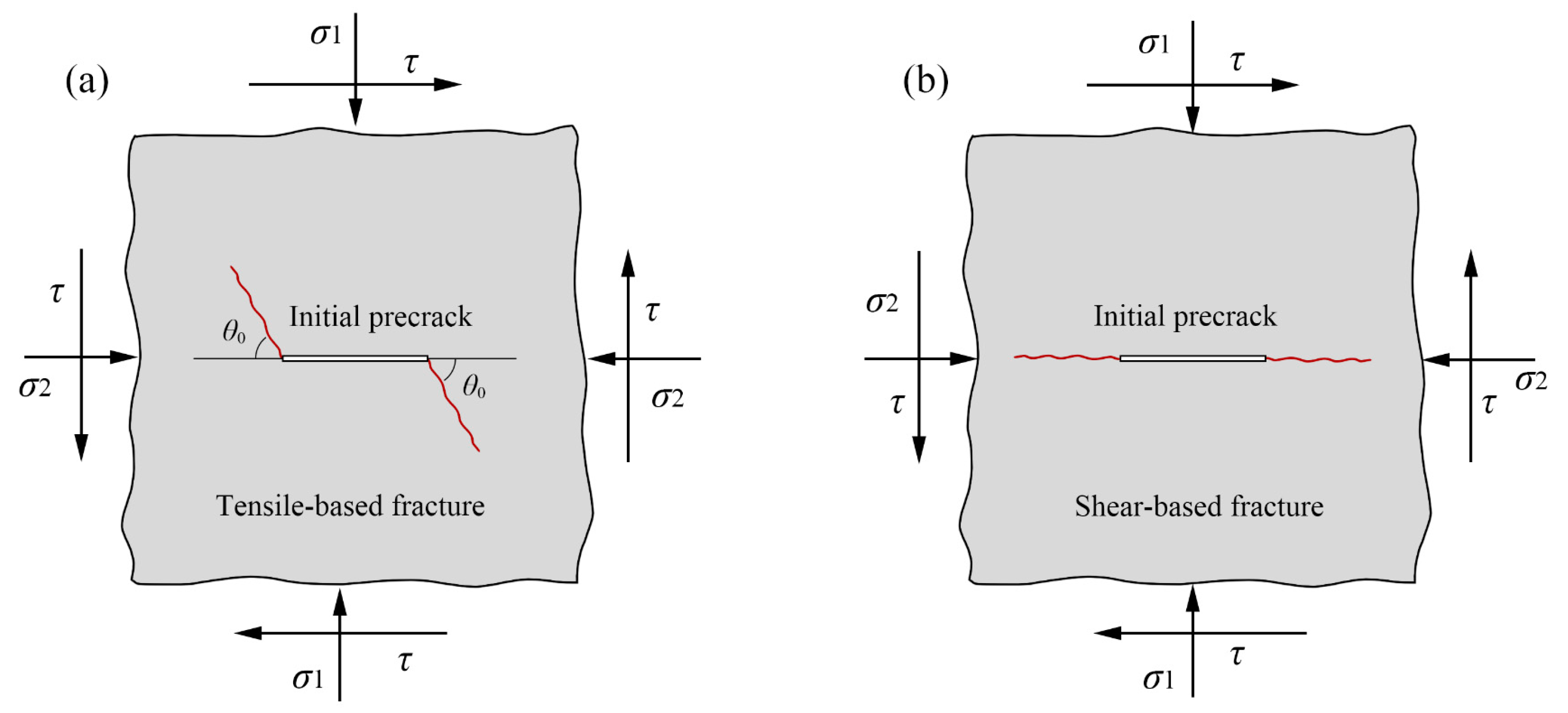
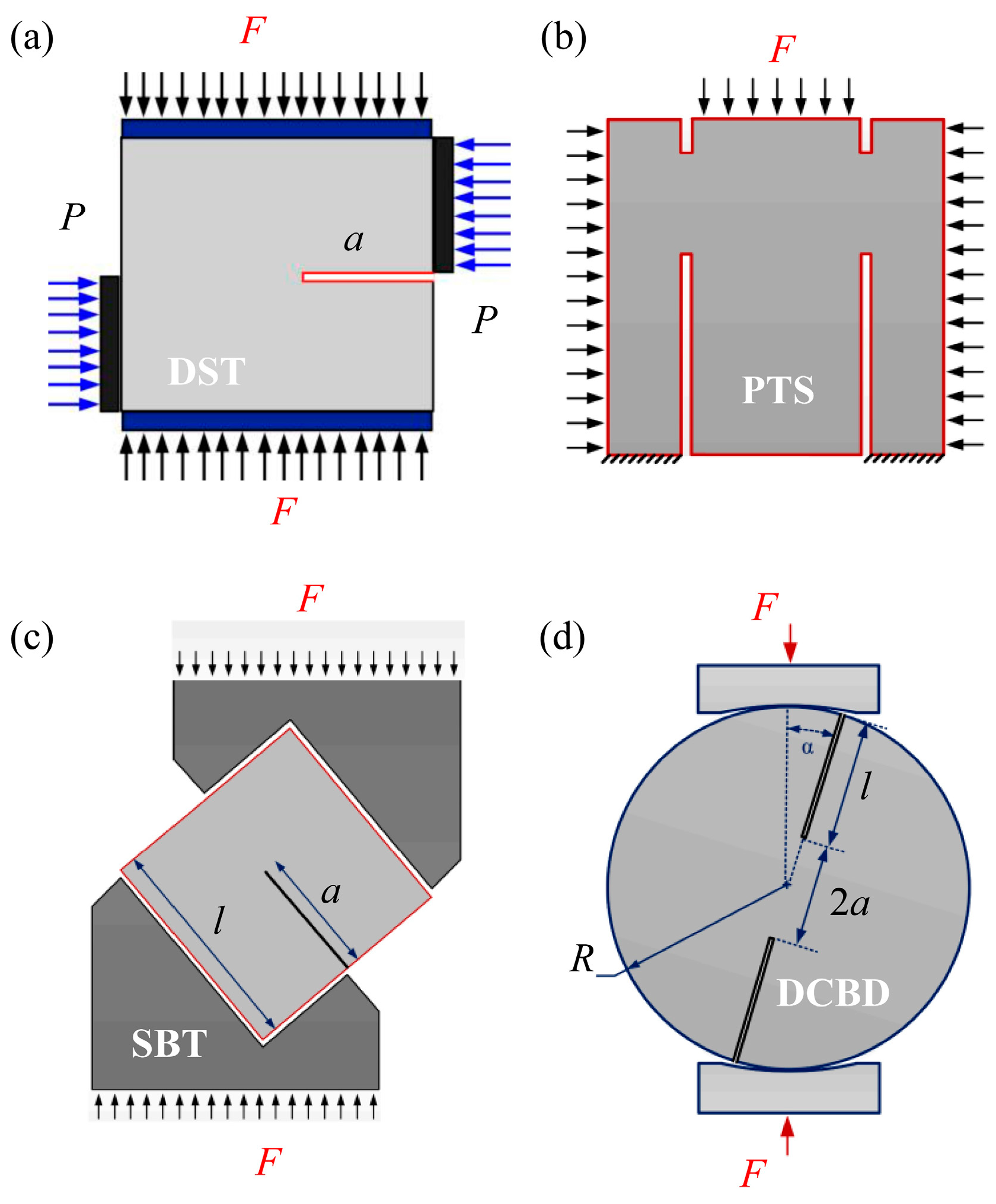
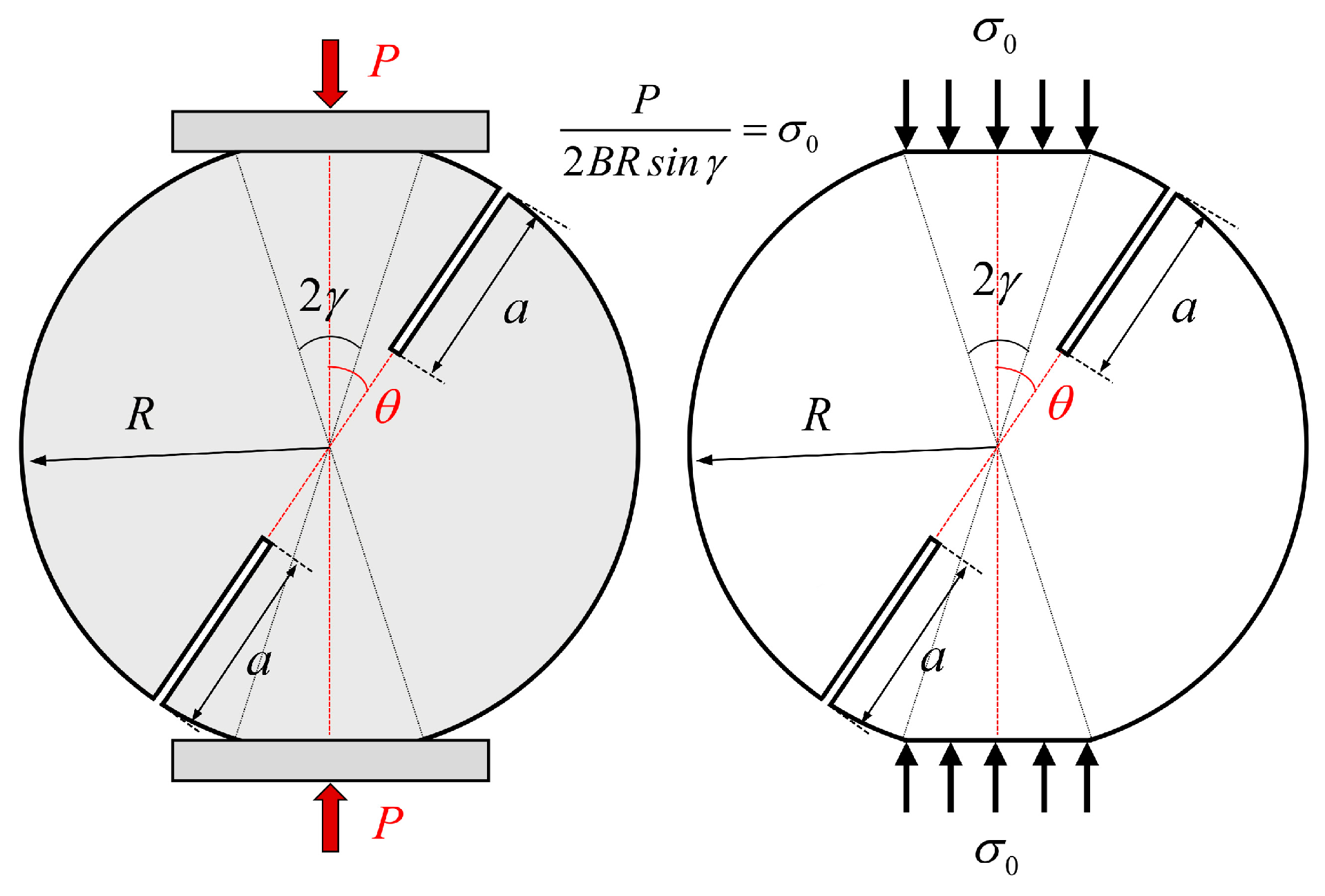
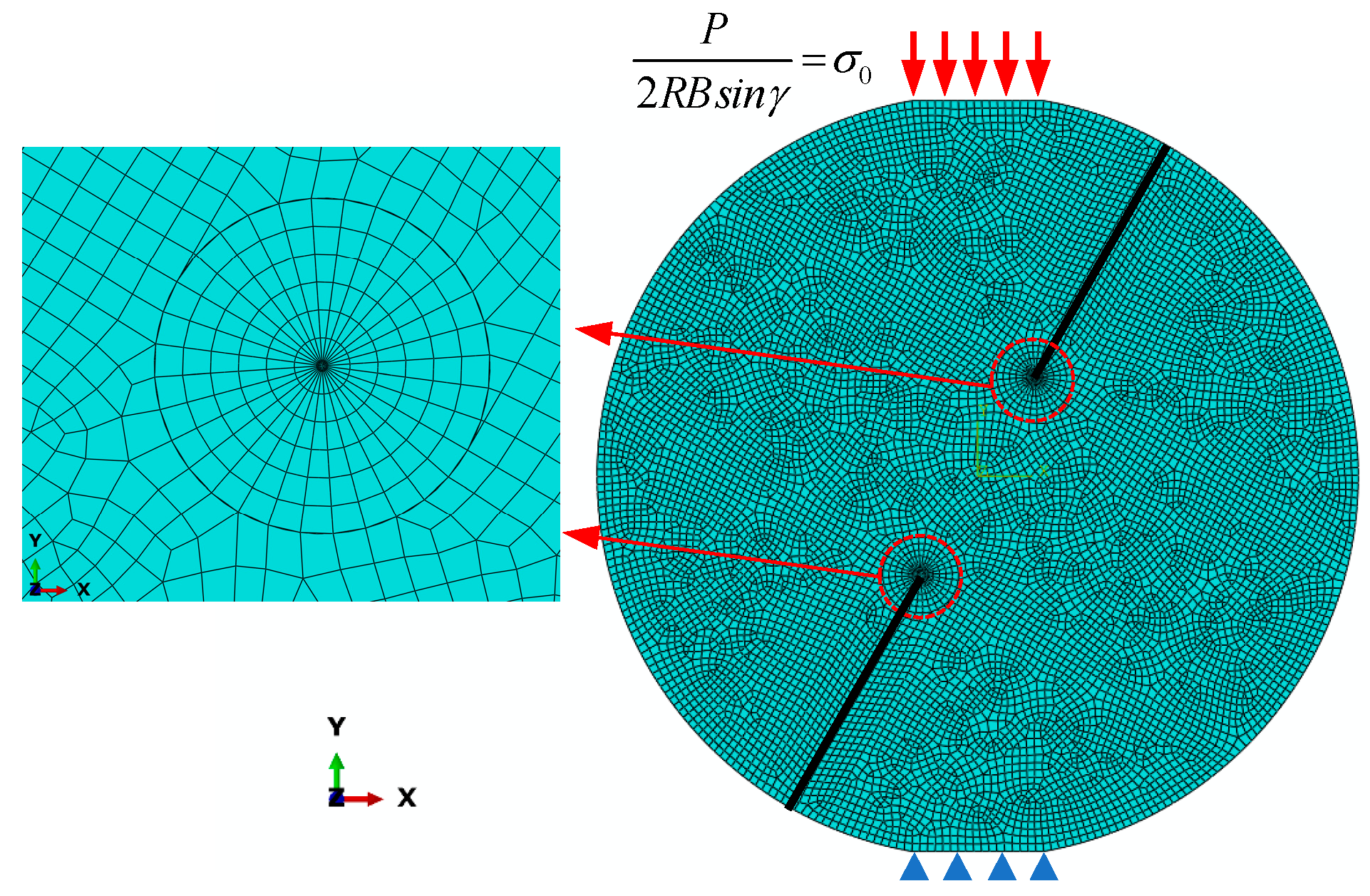
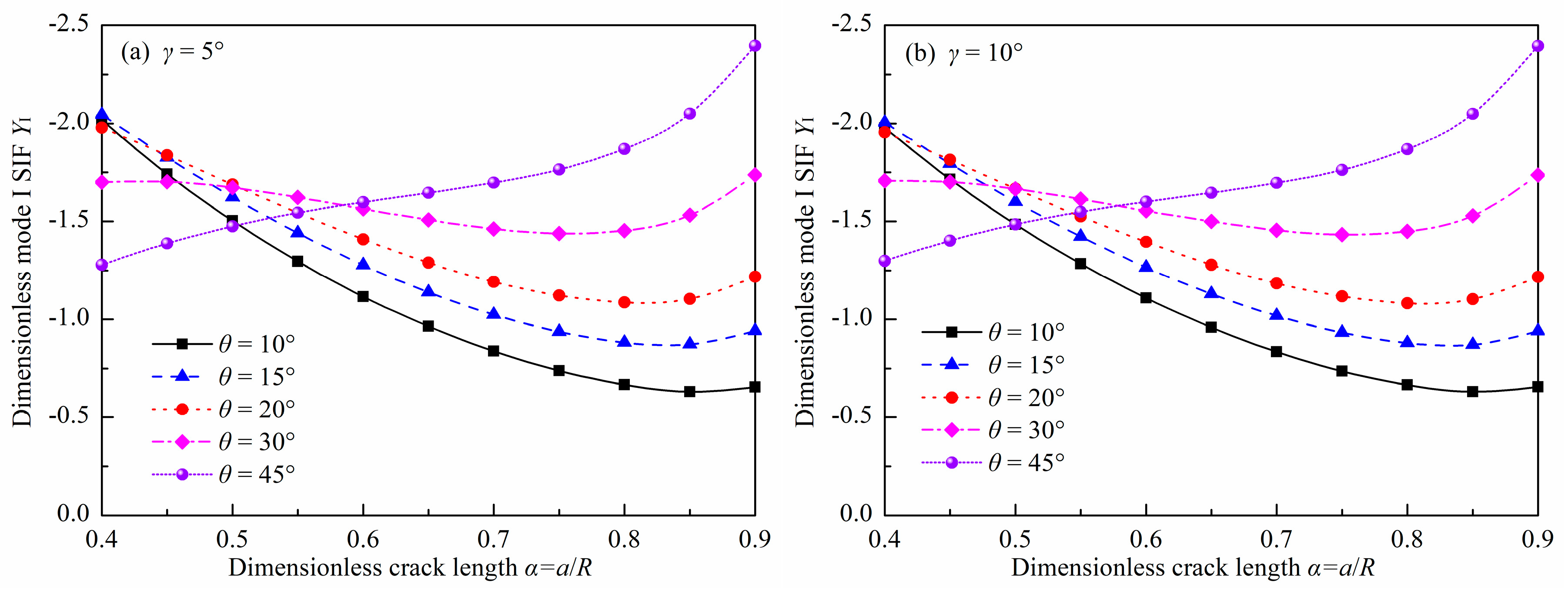

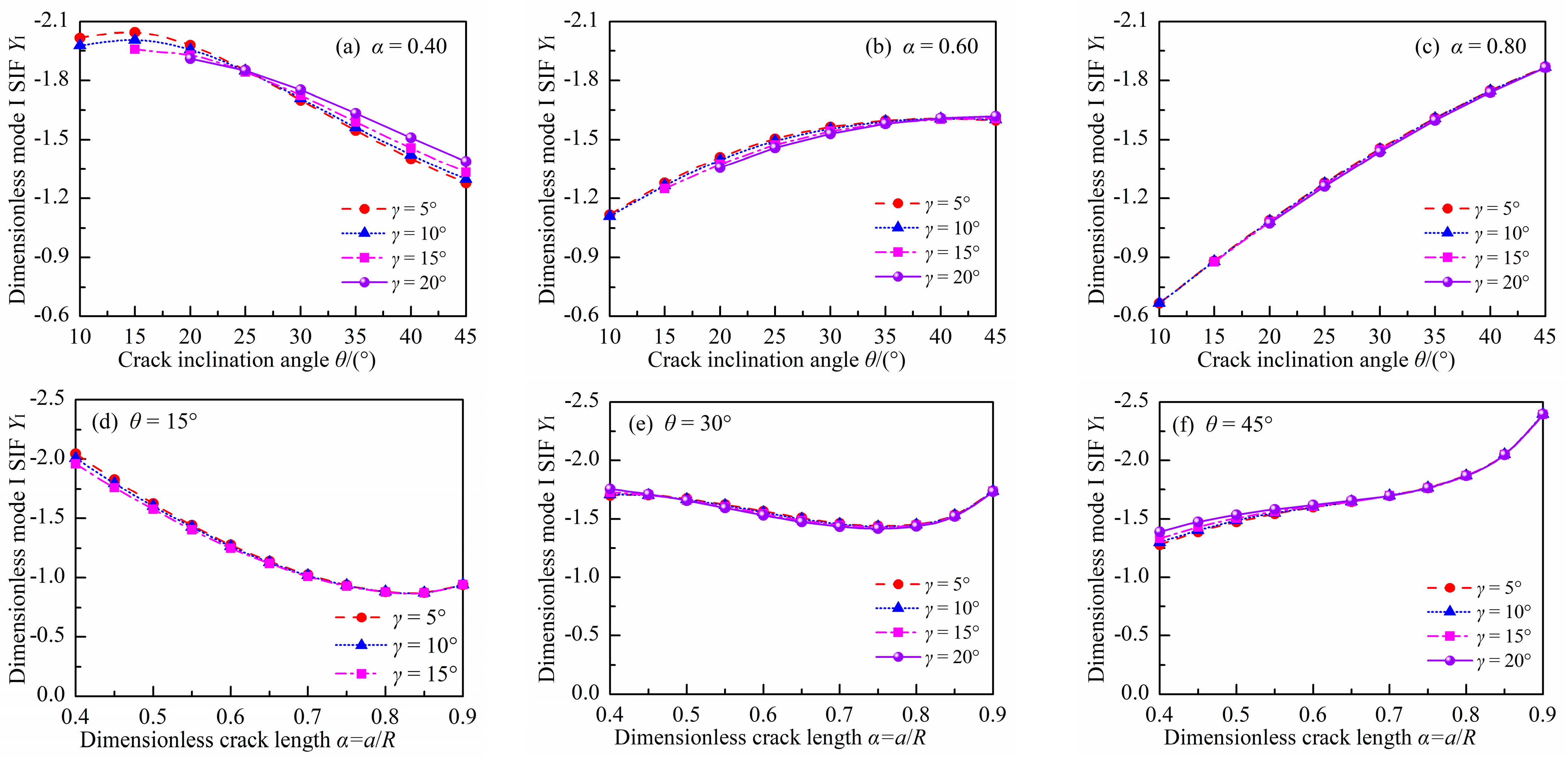

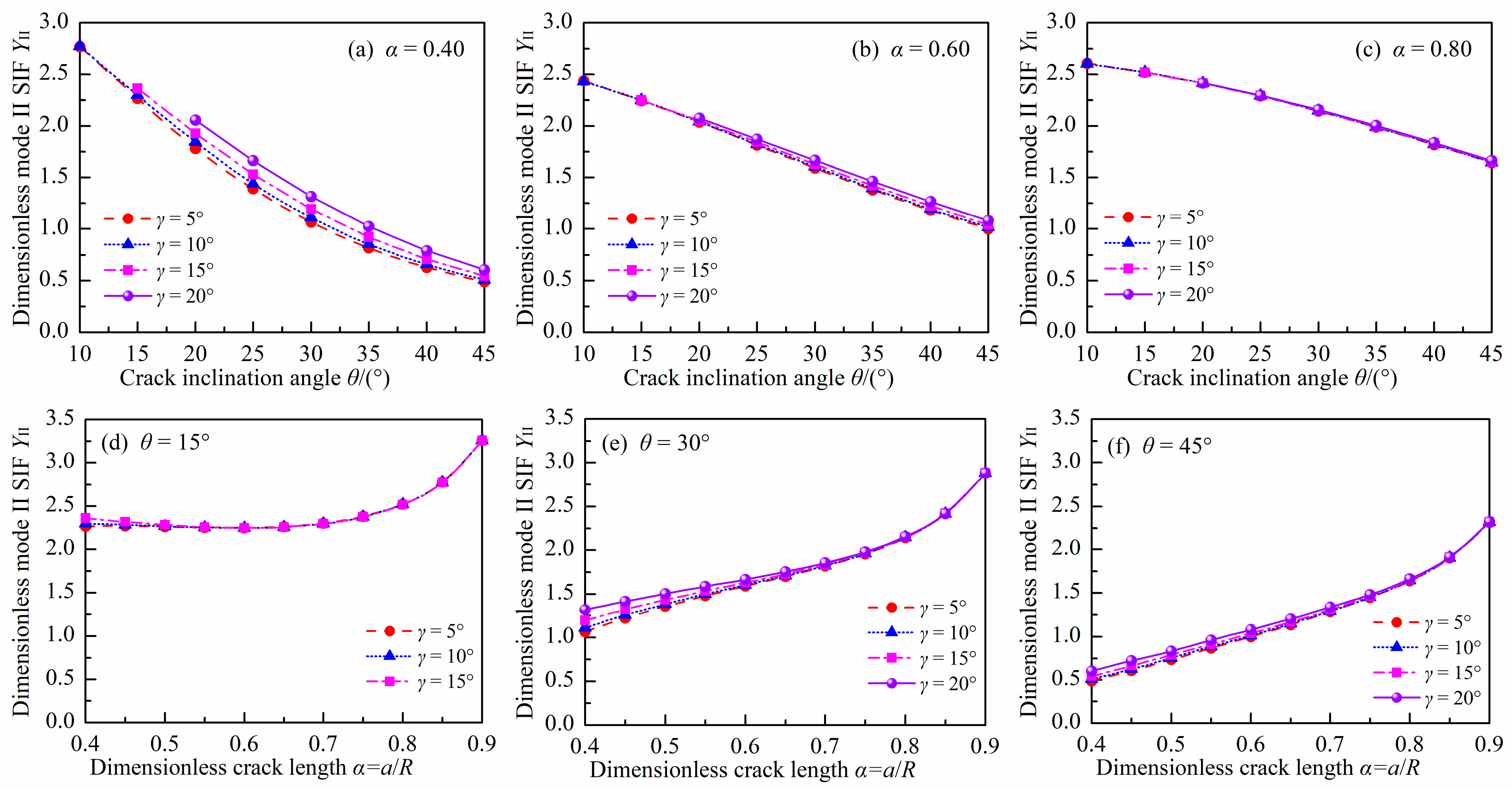
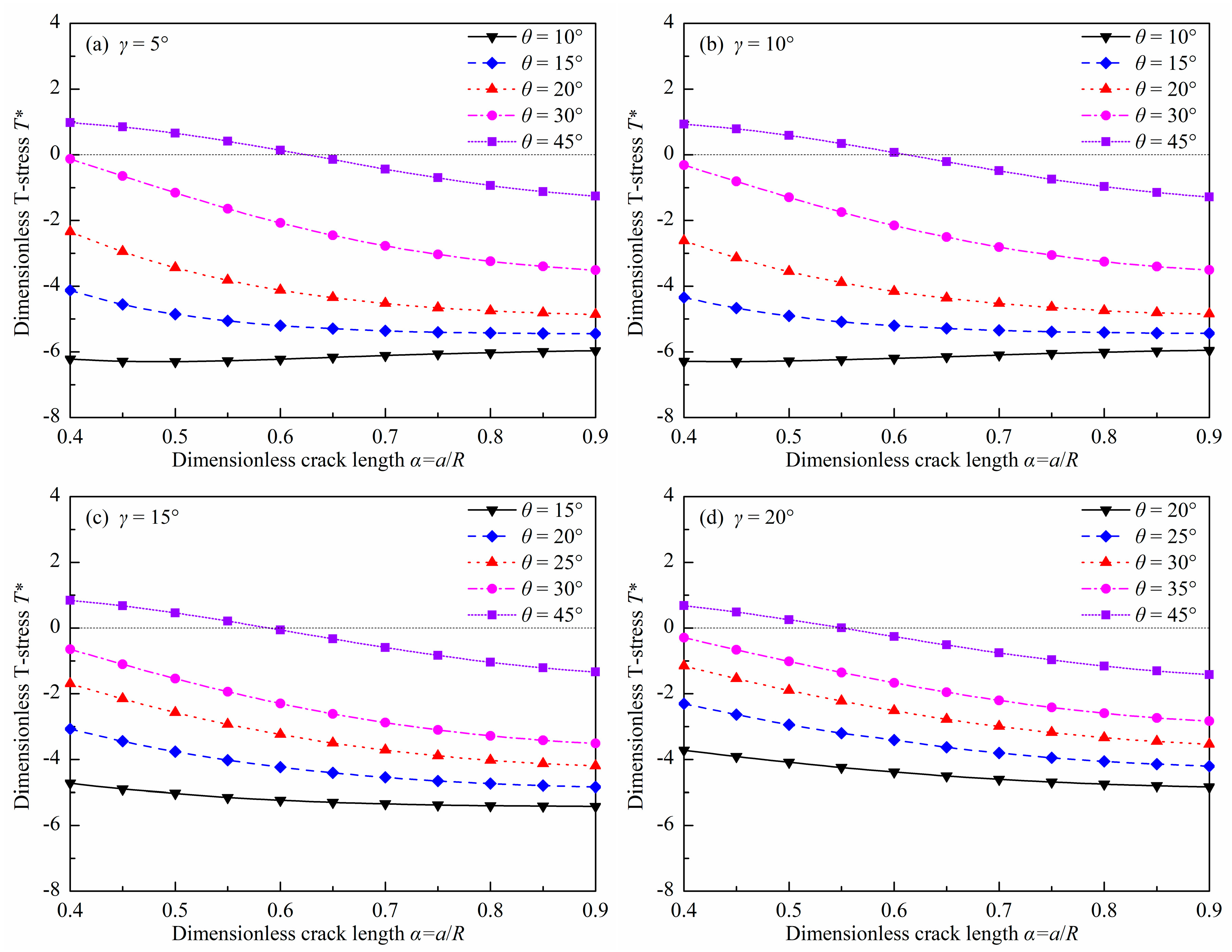
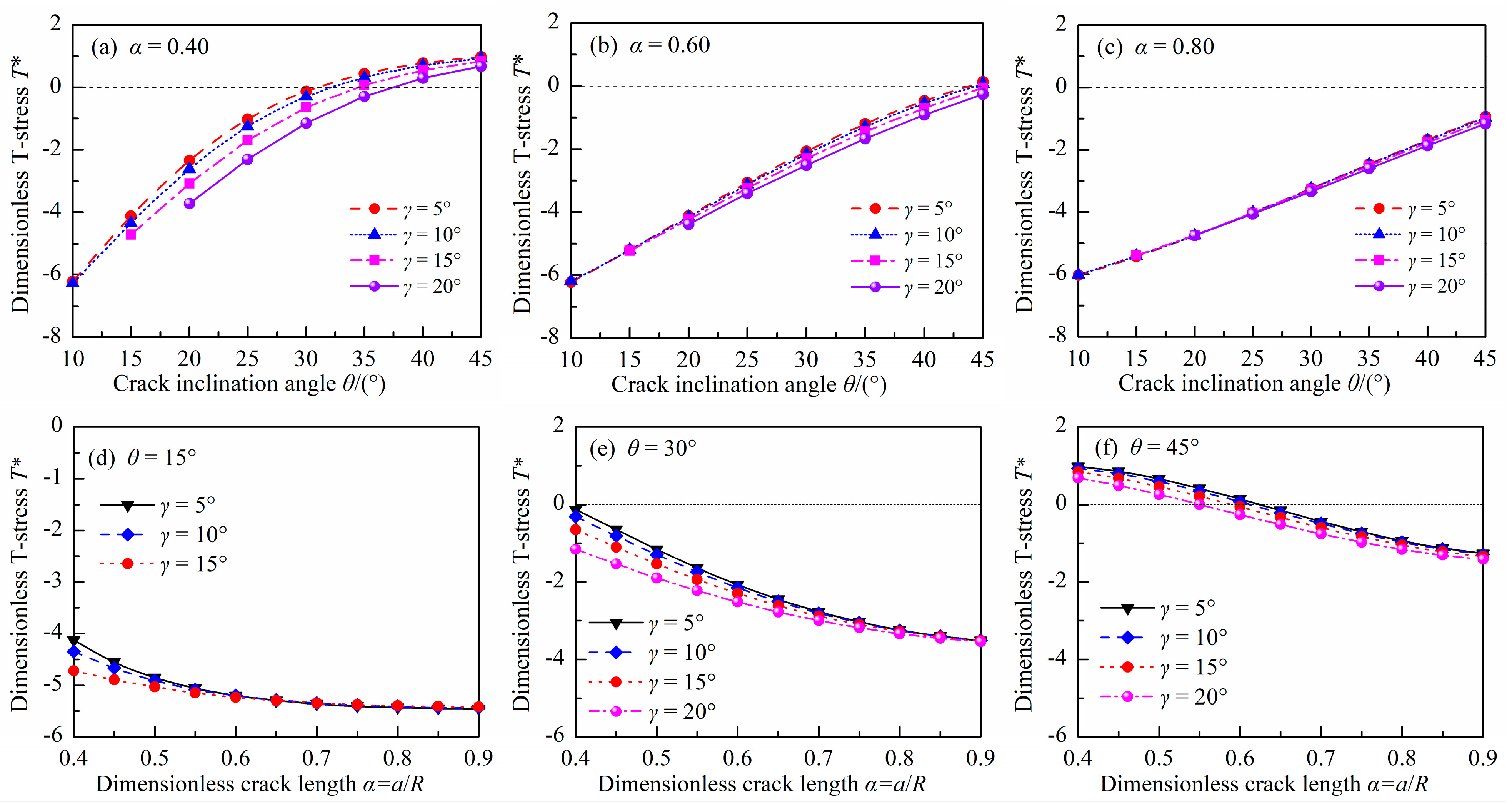


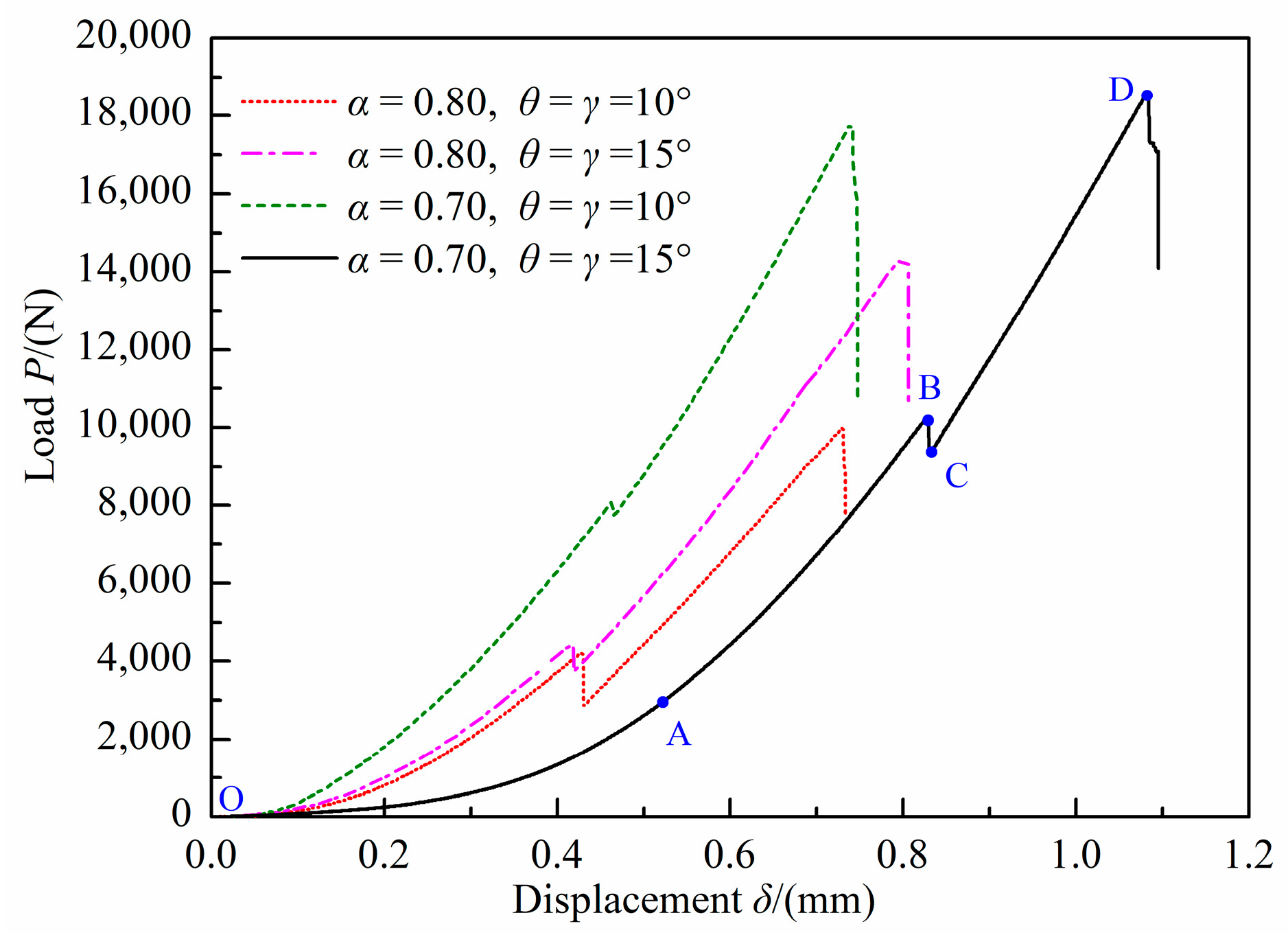
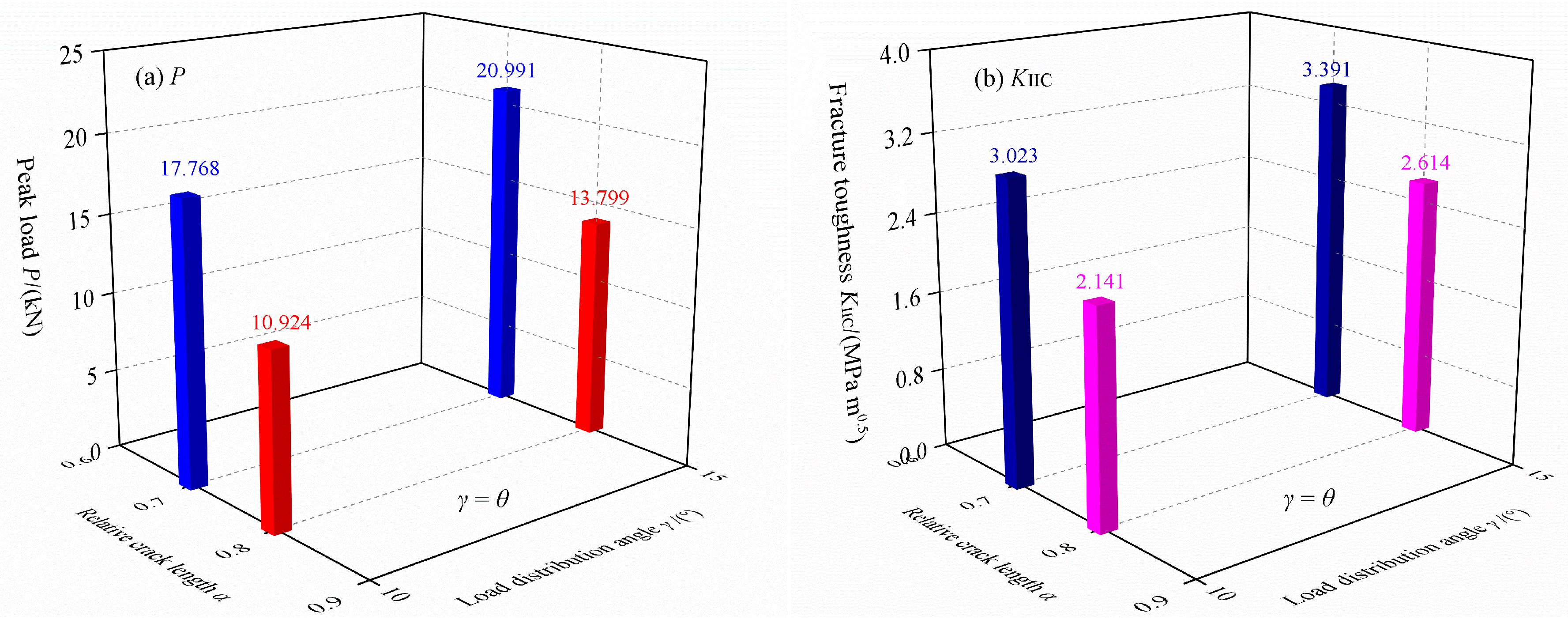
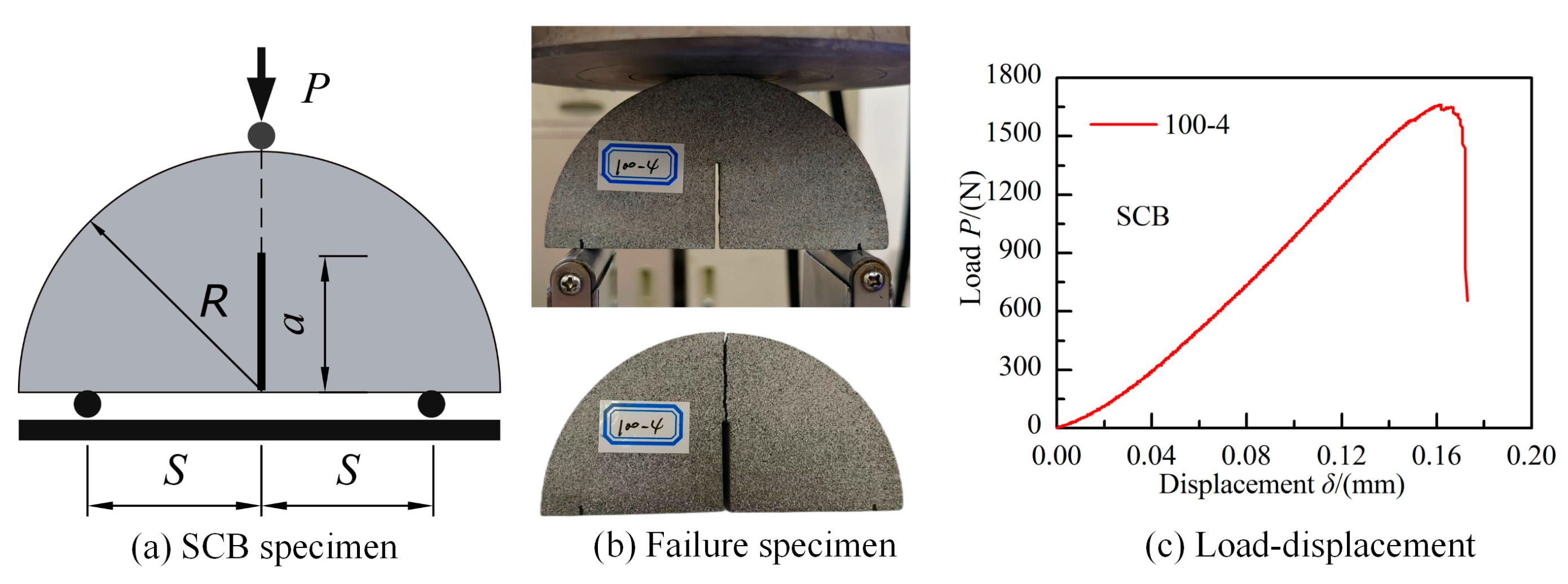
| Parameters | Values |
|---|---|
| Diameter | D = 100 mm |
| Dimensionless crack length | α = 0.40~0.90, with a increment of 0.05 |
| Load distribution angle | γ = 5°, 10°, 15°, 20° |
| Crack inclination angle | θ = 10°~45°, with a increment of 5° |
| Crack Inclination Angle and Load Distribution Angle | Dimensionless SIFs and T-Stress | Dimensionless Crack Length | ||
|---|---|---|---|---|
| α = 0.85 | α = 0.75 | α = 0.65 | ||
| θ = γ = 10° [4] | YI | −0.637 | −0.740 | −0.965 |
| YII | −2.835 | −2.468 | −2.405 | |
| T* | −6.025 | −6.133 | −6.215 | |
| θ = γ = 15° [4] | YI | −0.874 | −0.932 | −1.126 |
| YII | −2.761 | −2.373 | −2.255 | |
| T* | −5.499 | −5.450 | −5.395 | |
| θ = γ = 10° | YI | −0.632 | −0.736 | −0.959 |
| YII | −2.850 | −2.476 | −2.406 | |
| T* | −5.973 | −6.049 | −6.148 | |
| θ = γ = 15° | YI | −0.870 | −0.927 | −1.118 |
| YII | −2.772 | −2.375 | −2.258 | |
| T* | −5.408 | −5.374 | −5.294 | |
| Relative Crack Length α = a/R | Loading Angle θ = γ/° | Dimensionless SIF YII | Peak Load P/kN | Average Peak Load P0kN | True II Fracture Toughness KIIC/MPa m0.5 |
|---|---|---|---|---|---|
| 0.80 | 10 | 2.605 | 10.477 | 10.924 | 2.141 |
| 11.572 | |||||
| 10.022 | |||||
| 9.987 | |||||
| 12.564 | |||||
| 15 | 2.519 | 14.899 | 13.799 | 2.614 | |
| 12.259 | |||||
| 13.503 | |||||
| 14.320 | |||||
| 14.014 | |||||
| 0.70 | 10 | 2.418 | 18.774 | 17.768 | 3.023 |
| 16.182 | |||||
| 17.099 | |||||
| 17.781 | |||||
| 19.007 | |||||
| 15 | 2.296 | 21.335 | 20.991 | 3.391 | |
| 23.134 | |||||
| 22.715 | |||||
| 19.183 | |||||
| 18.592 |
Disclaimer/Publisher’s Note: The statements, opinions and data contained in all publications are solely those of the individual author(s) and contributor(s) and not of MDPI and/or the editor(s). MDPI and/or the editor(s) disclaim responsibility for any injury to people or property resulting from any ideas, methods, instructions or products referred to in the content. |
© 2025 by the authors. Licensee MDPI, Basel, Switzerland. This article is an open access article distributed under the terms and conditions of the Creative Commons Attribution (CC BY) license (https://creativecommons.org/licenses/by/4.0/).
Share and Cite
Hua, W.; Zhang, W.; Dong, S.; Li, J.; Huang, J.; Luo, P.; Zhu, Z. Fracture Mechanical Properties of Double-Edge Cracked Flattened Brazilian Disc Samples Under Compressive Loads. Materials 2025, 18, 850. https://doi.org/10.3390/ma18040850
Hua W, Zhang W, Dong S, Li J, Huang J, Luo P, Zhu Z. Fracture Mechanical Properties of Double-Edge Cracked Flattened Brazilian Disc Samples Under Compressive Loads. Materials. 2025; 18(4):850. https://doi.org/10.3390/ma18040850
Chicago/Turabian StyleHua, Wen, Wenyu Zhang, Shiming Dong, Jianxiong Li, Jiuzhou Huang, Ping Luo, and Zhanyuan Zhu. 2025. "Fracture Mechanical Properties of Double-Edge Cracked Flattened Brazilian Disc Samples Under Compressive Loads" Materials 18, no. 4: 850. https://doi.org/10.3390/ma18040850
APA StyleHua, W., Zhang, W., Dong, S., Li, J., Huang, J., Luo, P., & Zhu, Z. (2025). Fracture Mechanical Properties of Double-Edge Cracked Flattened Brazilian Disc Samples Under Compressive Loads. Materials, 18(4), 850. https://doi.org/10.3390/ma18040850






